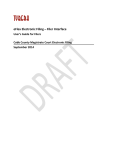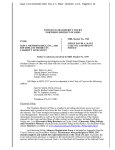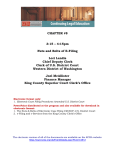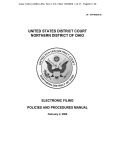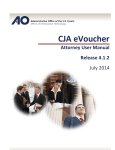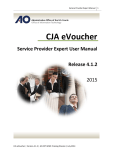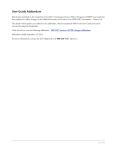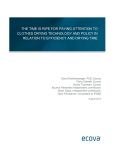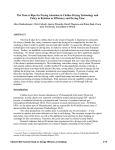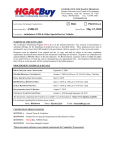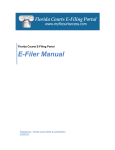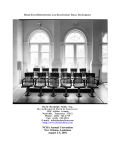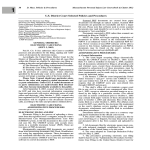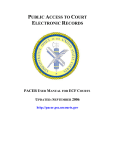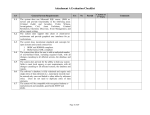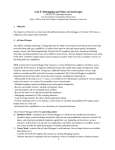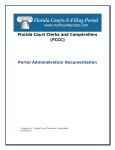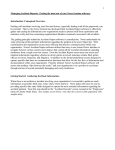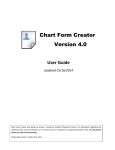Download CM/ECF Attorney Manual - United States Court of Appeals for the
Transcript
Bookmarks U. S. COURT OF APPEALS FOR THE FOURTH CIRCUIT Case Management CM / ECF Electronic Case Files ATTORNEY MANUAL April 2015 TABLE OF CONTENTS WHAT’S NEW IN THIS UPDATE OF THE USER GUIDE..................................... ii I. GETTING STARTED ...................................................................................1 II. POLICIES AND PROCEDURES ...................................................................5 III. HOW TO USE THE CM/ECF SYSTEM – STEP BY STEP .......................... 18 IV. REPORTS ................................................................................................... 31 V. QUALITY CONTROL AND ERROR CORRECTION ................................. 36 VI. TRAINING AND CERTIFICATION............................................................ 37 VII. QUESTIONS ............................................................................................... 37 04/29/2015 JJQ i Fourth Circuit CM/ECF User Manual WHAT’S NEW IN THIS UPDATE OF THE USER GUIDE? April 29, 2015 Update Section Description of Change Throughout Added "(court access)" to all SEALED DOCUMENT, SEALED BRIEF and SEALED APPENDIX entry references due to an update to the filing event dictionary. December 22, 2014 Update Section II.A.4 Description of Change Revised information regarding number of paper copies of briefs and appendices required when appellant/petitioner is proceeding in forma pauperis under Standing Order 14-1 (http://www.ca4.uscourts.gov/docs/rules/standingorder1401.pdf?sfvrsn=4). March 1, 2014 Update Section II.B.1.c Description of Change Removed information regarding answering 8 out of 10 questions correctly on the Fourth Circuit Electronic Case Filing Application. November 9, 2012 Update Section I. B. 7 Description of Change Updated to indicate that Java 7 is compatible with the current version of CM/ECF October 16, 2012 Update Section II. B. 2 VI. A Throughout 04/29/2015 JJQ Description of Change Replaced “Training Requirements” with Fourth Circuit Electronic Case Filing Application. Updated Training Information Updated screen shots to reflect current category selections. ii Fourth Circuit CM/ECF User Manual July 2, 2012 Update Summary – Updated information to reflect July 2, 2012, Local Rule 25(a) & 32(b) amendments and other technical updates. Section I, A, a and b Description of Change Updated file size limit to 50MB and combined limit to 250MB. II, A, 4 Updated to reflect electronic appendix requirements. II, C, 3, b Updated to reflect electronic appendix requirements. II, D, 1 Updated to reflect service requirements for appendix. II, D, 6, a Updated to reflect that only one copy of case initiating document is required to be filed with the court. II, D, 6, b Updated to reflect service requirements for appendix. II, G, 1, d Deleted information regarding paper appendices. II, G, 3 Throughout Updated to reflect service requirements for appendix. Updated to refer to Local Rule 25(a) which supersedes Administrative Order 08-01 March 30, 2012 Update Section Description of Change I, 4 Updated PACER fee information. IV, A Update PACER fee information. March 20, 2012 Update Section II, K 04/29/2015 JJQ Description of Change Added information regarding filing when technical difficulties are iii Fourth Circuit CM/ECF User Manual encountered. January 30, 2012 Update Section I, A, 5 Description of Change Added information regarding Checking PDF Documents utility. December 12, 2011 Update Section Description of Change I, B, 1 Updated information regarding CM/ECF and Apple Macintosh Computers. I, B, 7 Added that Appellate CM/ECF does not currently work with Java 7 II, A, 2 Added to clarify that service of initiating documents submitted electronically must be served conventionally II, B, 1 Added to clarify that non-bar members may register for ECF prior to being admitted and that bar applications may be submitted electronically. II, B, 4 Added information for user to contact PACER Service Center at 800676-6856 II, F, 3 Updated file size limit to 20MB. III, G Added link to attorney event dictionary: http://www.ca4.uscourts.gov/caseinformationefiling/efiling_cmecf/filingevents October 18, 2011 Update Summary – Updated documentation to reflect that the entry SEALED DOCUMENT OR MOTION is now SEALED DOCUMENT. Section Description of Change II, D, 5 Changed SEALED DOCUMENT OR MOTION to SEALED DOCUMENT. II, G, 4, a Changed SEALED DOCUMENT OR MOTION to SEALED 04/29/2015 JJQ iv Fourth Circuit CM/ECF User Manual DOCUMENT. V, C, 2, a Changed SEALED DOCUMENT OR MOTION to SEALED DOCUMENT. July 5, 2011 Update Summary – Updated links to PACER sites. Updated information regarding motions to withdraw in criminal cases. Section Description of Change II, A, 4, 2 Updated to reflect motions to withdraw by counsel in a criminal case that is not a member of the bar or a Fourth Circuit ECF filer maybe submitted outside of ECF. II, A, 4, Table Updated to reflect motions to withdraw by counsel in a criminal case that is not a member of the bar or a Fourth Circuit ECF filer maybe submitted outside of ECF.. March 29, 2011 Update Summary - Updated manual to reflect implementation of Pay.gov and attorney entry updates. Section II, A, 4, 2 II, A, 4, Table II, B, 1 Description of Change Updated to reflect that case-initiating documents may be submitted electronically. Added Application for Admission to Bar information; updated information regarding case-initiating document submission. Updated to reflect attorneys may file bar application electronically. II, B, 1, c Added information on Fourth Circuit Electronic Case Filing Application II, B, 1, d Updated court ECF account approval process information. II, D, 6, a Updated information regarding case-initiating documents. Updated attorney filing entries, removing the word “Filed” from entry title Updated screen shots to ensure they match the current database configuration. 04/29/2015 JJQ v Fourth Circuit CM/ECF User Manual I. GETTING STARTED A. Definitions 1. Electronic Filing: The process of uploading a document from the filer’s computer, using the court’s Internet-based Case Management/Electronic Case Filing System (CM/ECF) to file the document in the court’s case file. The CM/ECF System accepts documents only in Portable Document Format (PDF). 2. Filing User: An individual who has a login and password to file documents electronically using the court’s CM/ECF System. Because an individual can use the same login and password to file in any federal appellate court in which the individual has registered, the terms Appellate Filer and Appellate ECF Filer are also used. 3. Notice of Docket Activity (NDA): A notice generated automatically by the CM/ECF System at the time a document is filed electronically. The notice sets forth the date and time of filing, the party filing the document, the text of the docket entry created by the filing, a hyperlink to the PDF document filed, and the names of the participants served by email and U.S. mail. It is a good practice to save or print the Notice of Docket Activity as proof of the filing. 4. PACER: “Public Access to Court Electronic Records” is an automated system that allows subscribers to view, print, and download court docket information and documents over the Internet. The PACER systems allows case participants “one free look” at documents served electronically. The NDA for each filing will contain a hyperlink to the document(s) filed. The document should be saved or printed when it is first opened from the NDA. Subsequent electronic access to the document or electronic access to the docket through PACER will be billed by the PACER Service Center at $0.10/page with a maximum charge of $3.00 per document. No billing is done by the PACER Service Center until a user’s charges exceed $15 in a year. 5. PDF: “Portable Document Format” means that the document’s format is deviceindependent, resolution- independent, and fixed-layout. The document can be viewed as created, regardless of the software that created it because PDF files do not encode information that is specific to the application software used to create the document. WordPerfect versions 9, 10, 11, and 12 include the capability to convert text documents to PDF by clicking “File” on the toolbar and then “Publish to PDF”. Microsoft Word 2007 and later has built in PDF conversion software. You may also use Adobe Acrobat Pro or download free PDF conversion software from any source of your choosing. Refer to the “Help” option in your conversion software for instructions on converting documents to PDF. 04/29/2015 JJQ 1 Fourth Circuit CM/ECF User Manual Appellate CM/ECF includes a utility that allows users to check PDF documents for compliance prior to filing. • To access the utility, login to CM/ECF, select Utilities, Check PDF Document. • The Select the File to Inspect for PDF Filing Requirements box will appear. • Select the file to be checked. • Select Open. • A message will appear indicating if the file format is acceptable or not. • NOTE: The Check PDF Document utility does not check for file size, which must be less than 50MB or text searchability of briefs. Interactive on-line training on converting Word or Word Perfect Documents to PDF is available at http://www.pacer.gov/ecfcbt/dc/cccnvtpdf/. 04/29/2015 JJQ 2 Fourth Circuit CM/ECF User Manual There are two types of PDF files. Whenever possible, text PDF files must be used. a. Text PDF: Electronically converted PDF documents are created from word processing documents (MS Word, WordPerfect, etc.) using Adobe Acrobat or similar software. Text PDF documents are text searchable and their file size is small. Text PDF documents up to 50 megabytes can be uploaded as one file; documents of larger size should be split into separate files with appropriate identification. Up to 250 megabytes can be uploaded per docket entry. b. Scanned Image PDF: Scanned image PDF documents are created by putting paper documents through an optical scanner. Scanned image PDF documents are not text searchable and have a large file size. If a scanned image PDF must be created because the electronic document is unavailable, the paper document should be scanned at 300dpi with the “black and white” setting. Scanned image PDFs up to 50 megabytes can be uploaded as one file; documents of larger sizes should be split into separate files with appropriate identification. Up to 250 megabytes can be uploaded per docket entry. B. Hardware and Software The following hardware and software are needed for CM/ECF: 1. Computer: • A personal computer running Windows with Internet Explorer 6.0 (or higher) or Mozilla Firefox 3.0 (or higher). OR • Mac users running Snow Leopard or higher may utilize the standard CM/ECF login page to access the system. OR • Mac users running Leopard must log into Fourth Circuit CM/ECF via a special web link: https://ecf.ca4.uscourts.gov/cmecf/servlet/TransportRoom?servlet=Login?clie nt=mac. OR 2. Word Processing Software: Word Perfect, Microsoft Word or any other word processing software that will allow you to convert text documents to PDF. 3. Internet Service Provider and Web Browser: CM/ECF has been certified to work with Mozilla Firefox versions 3.0 or higher and Internet Explorer versions 6.0 or higher. 4. Email Account: You may register more than one email address for receipt of Notices of Docket Activity. The address(es) must be regularly monitored, as your only notification of case activity will be via email. Notices of Docket Activity will be sent from the court’s ECF System. Counsel must ensure that the spam filter operation on the network and computer receiving the email are set to allow notices from [email protected]. The size of your email account must be sufficient to receive Notices of Docket Activity from the ECF System. ECFrelated email may exceed the size allocated for free email accounts. In general, an account with storage space of at least 100 megabytes is sufficient. 5. PDF Conversion Software: WordPerfect versions 9, 10, 11, and 12 include the capability to convert text documents to PDF by clicking “File” on the toolbar and 04/29/2015 JJQ 3 Fourth Circuit CM/ECF User Manual then “Publish to PDF”. Microsoft Word 2007 and later has built in PDF conversion software. You may also use Adobe Acrobat Pro or download free PDF conversion software from any source of your choosing. Refer to the “Help” option in your conversion software for instructions on converting documents to PDF. Interactive on-line training on converting Word or Word Perfect Documents to PDF is available at http://www.pacer.gov/ecfcbt/dc/cccnvtpdf/. 6. Scanner: Use a scanner ONLY if you do not have access to an electronic version of the document that would enable you to prepare a text PDF. Paper documents should be scanned into PDF image format at 300dpi with a “black and white” setting. 7. Java Runtime Environment (JRE): Java is required for CM/ECF to operate on your computer. Java 7 is compatible with the current version of Appellate CM/ECF. For information related to Macintosh computers see item #1. 04/29/2015 JJQ 4 Fourth Circuit CM/ECF User Manual II. POLICIES AND PROCEDURES (Local Rule 25) A. Scope of Electronic Filing – Local Rule 25 (a)(1) 1. Effective Date: Electronic filing for attorneys began on April 1, 2008 and became mandatory on June 1, 2008. 2. Service of Electronic Documents: Conventional service is required only on those case participants who were not served electronically through CM/ECF as identified on the Notice of Docket Activity. Any case initiating documents for petitions for review and petitions for permission to appeal submitted electronically must be served conventionally. 3. Persons Covered: All attorneys filing documents in the Fourth Circuit must file electronically using CM/ECF (regardless of when the case was initially opened) unless counsel applies for and the court grants an exemption for good cause shown in a particular case. Pro se litigants generally file documents conventionally. A pro se litigant may, however, request permission to file documents electronically in an individual case upon a showing that the litigant has satisfied the requirements for registration as a Filing User. 4. Specific Documents: All documents filed by counsel of must be filed electronically in PDF format (textPDF, if available) except that: 1. Formal briefs and appendix are filed in electronic AND paper form. 2. Case initiating documents such as petitions for review and petitions for permission to appeal may be submitted electronically or in paper form. Counsel must serve respondent(s) case initiating documents in hard copy. For more information on submitting case-initiating documents electronically, see eFiling (CM/ECF). 3. CJA and other payment vouchers are filed in paper form only, 4. Motions to withdraw in criminal cases when counsel is not a Fourth Circuit ECF filer and/or a member of the court’s bar. Please contact the Fourth Circuit ECF help desk at 804-916-2767 for filing instructions. Type of Document How to File Application for Admission to the Bar Submit electronically or by mail. Case initiating documents-- petitions for permission to appeal, petitions for review, applications for enforcement, petitions for mandamus or prohibition, motions to authorize successive habeas petitions Submit electronically or file original in paper form in court of appeals; provide electronic text version in PDF form upon request. Counsel must serve respondent(s) case initiating documents in hard copy. Notice of appeal File electronically in district court. 04/29/2015 JJQ 5 Fourth Circuit CM/ECF User Manual Forms required within 14 days of case opening-- appearance of counsel, disclosure of corporate affiliations, docketing statement, transcript order form File electronically in court of appeals. Motions, responses, replies File electronically in court of appeals. Exhibits should be filed as part of the Motion or Response/answer event. Exhibits that were filed in district court as PDF text documents should be downloaded from the district court docket and included as PDF text exhibits with the motion or response. Exhibits must be clearly identified by letter or number. EXCEPT motions to withdraw in criminal cases when counsel is not a Fourth Circuit ECF filer and/or a member of the court’s bar. Please contact the Fourth Circuit ECF help desk at 804-916-2767 for filing instructions. Formal briefs File electronically in court of appeals using BRIEF event; also file 8 copies in paper form. If the appellant/petitioner is proceeding in forma pauperis, only 1 paper copy of the brief is required (3 additional copies are required if the case is tentatively calendared for argument). Paper copies should be mailed or delivered the same day the electronic brief is filed; however, paper copies of a briefing document will be accepted without a motion if filed no more than one day late. Service of courtesy paper copies is not required, although counsel may agree to such service. Sealed version of formal briefs File electronically in court of appeals using SEALED BRIEF (court access) event. Paper copies of the sealed brief are filed with the court and served on all parties entitled to access the sealed brief. Counsel must also file a certificate of confidentiality for the sealed version of the brief. The redacted version of the brief is filed using the BRIEF entry. Paper copies of the redacted brief are filed with the court but not served on the parties. 04/29/2015 JJQ 6 Fourth Circuit CM/ECF User Manual Appendix See Federal & Local Rules 31 & 32 & Local Rule 25(a)(1)(D) for complete information Full Electronic Appendix (option 1) Appendices must be filed in electronic and paper form. Under option 1, appellant files the full appendix in electronic form, separately filing any sealed documents as a sealed appendix. File 6 paper copies in paper form in court of appeals. If the appellant/petitioner is proceeding in forma pauperis, only 1 paper copy of the appendix is required (3 additional copies are required if the case is tentatively calendared for argument). Serve any non-ECF users with a full paper appendix. Electronic Appendix Excerpt (option 2) Under option 2, appellant files an electronic appendix excerpt containing the following excerpts from the appendix: • any sealed documents (filed as a sealed appendix); • any paper documents • any party filings in a social security case • any pertinent opinion, findings, magistrate report, or bankruptcy opinion • the opinion and order being appealed • the notice of appeal The excerpts should appear in the same order and with the same page numbers as in the full paper appendix. When the electronic excerpt option is used, all references in the brief must be to both the full paper appendix and the docket entry and page number of the district court record (JA 81; DE 20 at 5). With the electronic excerpt option, 200 additional words are allowed for principal briefs due to the parallel citation requirement. File 6 copies in paper form in court of appeals and serve full appendix in paper form. If the appellant/petitioner is proceeding in forma pauperis, only 1 paper copy of the appendix is required (3 additional copies are required if the case is tentatively calendared for argument). 04/29/2015 JJQ 7 Fourth Circuit CM/ECF User Manual Sealed Appendix Volumes Sealed record documents that are included in the appendix must be placed in a separate, sealed volume of the appendix. In consolidated criminal appeals, these materials must be separately sealed as to each defendant by marking the volume and envelope as SEALED – [DEFENDANT’S NAME] and serving the volume only on the government and counsel for the named defendant. Four paper copies and an electronic copy of sealed volumes of appendix are filed, together with a certificate of confidentiality. Service of paper copies of sealed appendix volumes is required since parties cannot access the electronic version. Indicate whether any sealed volumes are included and file 4 copies in paper form of any sealed volumes. If the appellant/petitioner is proceeding in forma pauperis, only 1 paper copy of the sealed appendix is required (3 additional copies are required if the case is tentatively calendared for argument). Certificate of confidentiality or motion to seal File electronically in court of appeals; also file 4 paper copies with sealed version of brief or sealed volume of appendix. Informal briefs File electronically in court of appeals and serve pro se litigants with paper copy. Most pro se litigants are not registered as filing users and therefore must be served conventionally. Notices regarding availability for argument File electronically in court of appeals. Acknowledgments of oral argument notification File electronically in court of appeals. Supplemental authorities, status reports, memoranda, correspondence File electronically in court of appeals. Petitions for rehearing and rehearing en banc File electronically in court of appeals. Bills of cost and objections to bills of cost File electronically in court of appeals. Criminal Justice Act and Assigned Counsel Vouchers Send to court of appeals in paper form; vouchers are not filed as part of the case file but instead are maintained as financial records. 04/29/2015 JJQ 8 Fourth Circuit CM/ECF User Manual B. Eligibility, Registration, Passwords – Local Rule 25 (a)(2) 1. Attorneys: Attorneys who intend to practice in the court should register as Filing User of the court’s CM/ECF System. Counsel who are not yet members of the Fourth Circuit bar have limited access to CM/ECF. Non-bar member ECF accounts do not have access to filing in cases but users can submit their Application for Admission to Practice electronically Fourth Circuit bar members will have access to filing in ECF upon activation of their account.. Follow the steps below to register as an ECF filer and if necessary, apply for membership to the court’s bar. a. Register with PACER for a PACER account: If you or your law firm has not previously obtained a PACER account (used to view documents), you must obtain a PACER account. Register for a PACER account at the PACER Registration web site. CM/ECF allows a filing attorney to permanently associate a PACER login with an ECF filing login. The ECF filing login and PACER login become associated by selecting Utilities, Manage My Account and checkingMake this my default PACER Login on the PACER login screen. When the two accounts are associated, each time the attorney logs in to file a document the system also logs the attorney in as a PACER customer. If you are a CJA attorney or Trustee and have two PACER accounts, you must switch between PACER accounts based on the type of work being performed. To remove a default PACER account, first, log on to Fourth Circuit CM/ECF. Select Utilities, Manage My Account. Select the Remove the default PACER Login checkbox and click the Apply button. b. Register with PACER for Appellate Filer Account: An Appellate Filer account is required to file documents through CM/ECF. An ECF account is also required to view documents in social security and immigration cases in which you are participating. Register for an appellate filer account at the PACER Service Center Appellate ECF Filer Registration website: https://www.pacer.gov/psco/cgi-bin/cmecf/ea-regform.pl. c. Complete Fourth Circuit Electronic Case Filing Application: The court requires that you complete the Fourth Circuit Electronic Case Filing Application. Detailed information regarding electronic filing policies and procedures can be found in Local Rule 25, our Attorney ECF On-line Training or this user manual. d. Court Approval Process: Once the court receives your ECF registration and Fourth Circuit Electronic Case Filing Application, your account will be activated within 24 hours. You will receive an automated email from the PACER Service Center indicating that your ECF account is active. If you are a member in good standing of the Fourth Circuit Bar, you will be able to file documents via CM/ECF immediately. If you are not yet a member of the Fourth Circuit Bar, you must submit your Application for Admission to Practice before you will be able to file electronically. Once your ECF account 04/29/2015 JJQ 9 Fourth Circuit CM/ECF User Manual is active, you may submit your Application for Admission to Practice via CM/ECF. Please review the Court’s web page for instructions on submitting your application electronically. Once your application has been processed, you will receive an email indicating that you are a member of the bar and electronic filing will be enabled for your ECF account. 2. Pro Se Litigants: Pro se litigants generally do not file documents electronically. However, a pro se litigant who is a party in a case before the court may request permission to file documents electronically in that case. To request permission, the pro se litigant should register with PACER as a pro se Appellate Filer, complete the Fourth Circuit Electronic Case Filing Application and file a motion for leave to file documents electronically in a case pending in the Fourth Circuit. The court will terminate a pro se party’s Filing User status upon the termination of the case or termination of the party’s pro se status. 3. Registration Constitutes Consent to Electronic Service: Completion of the Appellate Filer registration constitutes consent to electronic service of documents through CM/ECF. 4. Passwords: Your appellate ECF Filer login and password constitute your official signature on all documents filed using that login and password. a. Security: Filing Users agree to protect the security of their passwords. Contact the PACER Service Center and the clerk immediately if you learn that your password has been compromised. b. Changing your Password: Login to the PACER Appellate Filer Account Update site to change your password. c. Forgotten Password: If you forget your password, you can retrieve it electronically through the Pacer Service Center Forgotten Password Request website. You will need your account ID, security question answer and the email address and phone number associated with your account. The court cannot provide your password or re-set your password. Please contact the PACER Service Center at 800-676-6856 for password assistance. d. Delegation of Authority to Use Login and Password: You may allow a secretary, paralegal, or other authorized person to use your login and password to file documents on your behalf. Remember that your login and password constitute your signature regardless of whether you personally use them or you delegate that authority to someone else. e. Additional Email Recipients: A secondary account can be added at the time of registration for a login and password. If the account has already been created, you can update your account after logging into Fourth Circuit CM/ECF, by selecting Utilities, Update My Account, Edit My Information. At the login prompt, enter your Appellate ECF Filer login and password and click Verify Login. On the Account Update page, select Personal Info/Address Updates. To add an additional email address, select Update Noticing Preferences and enter the email address in the Additional Emails box. If you would like more than one additional email address to receive 04/29/2015 JJQ 10 Fourth Circuit CM/ECF User Manual notification in your cases, list all addresses in the Additional Emails box separated by a comma. Click Submit once all additional emails have been added. C. Consequences of Electronic Filing – Local Rule 25 (a)(3) 1. Filing Complete at Date and Time Stated on Notice of Docket Activity: Electronic transmission of a document to CM/ECF, together with the transmission of the Notice of Docket Activity from the court, constitutes filing of the document. Filing must be completed before midnight Eastern Time, as shown on the Notice of Docket Activity, to be considered timely filed that day. 2. Electronic Document is Official Record: When a document has been filed electronically, the official record is the electronic document stored by the court. Counsel must take care to verify the accuracy of the electronic document before committing the transaction to the docket. 3. Documents Accompanied by Motions to File or to Extend Filing Time: When leave of court or an extension of time is required to file a document, counsel files the motion using the appropriate motion event and the document using the appropriate document event. If the motion is granted, the document is deemed filed. If the motion is denied, the court will strike the underlying document. See examples below: a. Use Motion / extend filing time [opening brief] to file the motion. Use BRIEF (all formal, non-sealed briefs/electronic & paper form)to file the brief. If the court denies the motion, it will strike the brief. If the court grants the motion, the brief will remain on the docket. b. Use Motion / file supplemental appendix to file the motion. Use Appendix (electronic & paper format) and select the "supplemental" modifier to file the electronic supplemental appendix. File 6 copies (5 if counsel was appointed) in paper form in court of appeals. If the court denies the motion, it will strike the appendix. If the court grants the motion, the appendix will remain on the docket. D. Service of Documents by Electronic Means – Local Rule 25 (a)(4) 1. Service of Electronic Documents: Conventional service is required only on case participants who were not served electronically through CM/ECF, as identified on the Notice of Docket Activity except for case initiating documents which must be served conventionally and if the electronic appendix excerpt option is selected, the full appendix in paper form must be served on opposing counsel. 2. Preparing Certificate of Service: A certificate of service must be attached as the final page to all documents filed with the court, in accordance with FRAP 25(d). To ascertain how service should be accomplished on each party in order to prepare the certificate of service, use “Attorney Service Preference” report within 04/29/2015 JJQ 11 Fourth Circuit CM/ECF User Manual CM/ECF. See section IV(C) – Attorney Service Preference Report for more information on the report. Utilizing the report, complete the certificate of service in accordance with the example below: a. I certify that on _________________ the foregoing document was served on all parties or their counsel of record through the CM/ECF system if they are registered users or, if they are not, by serving a true and correct copy at the addresses listed below: b. A PDF writable certificate of service form is available at: http://www.ca4.uscourts.gov/pdf/certofservice.pdf. 3. Notice of Docket Activity Constitutes Service on Filing Users: The Notice of Docket Activity generated by the court’s CM/ECF System constitutes service of the filed document on participants served electronically through CM/ECF. The Notice of Docket Activity will state who has been served electronically through CM/ECF. 4. Conventional Service Required for Those Not Registered as Filing Users: Participants not served through CM/ECF must be served conventionally. To ascertain how service should be accomplished on each party in order to prepare the certificate of service, use “Attorney Service Preference” report within CM/ECF. See section IV(C) – Attorney Service Preference Report for more information on the report. 5. Conventional Service Required for Sealed Documents: The events used to file sealed documents – SEALED BRIEF (court access) (all formal, sealed briefs/electronic & paper form), SEALED APPENDIX (court access) and SEALED DOCUMENT (court access) – restrict electronic document access to court users only. Therefore, conventional service must be used for all sealed briefs and other sealed documents. 6. Conventional Service Required : See examples below. a. Case Initiating Documents: File original in paper form in court of appeals or submit electronically. All case initiating documents must be served conventionally. b. Appendix : File electronically using Appendix (electronic & paper format). File 6 copies in paper form (5 if counsel was appointed, 4 copies of any sealed volumes) with the court of appeals. . If the electronic appendix excerpt option is selected, the full appendix in paper form must be served on opposing counsel. All SEALED volumes of an appendix must be served conventionally. 7. 04/29/2015 JJQ Three Days Added to Prescribed Period if Service was by Electronic Means: Under FRAP 26(c), when a party is required or permitted to act with a prescribed period after a paper is served on the party, 3 calendar days are added unless the 12 Fourth Circuit CM/ECF User Manual paper is delivered on the date of service. A paper that is served electronically is not treated as delivered on the date of service. E. Entry of Court-Issued Documents-- Local Rule 25 (a)(5) Court orders, opinions, judgments, and other documents are filed electronically. Documents filed electronically without an original signature have the same effect as if the judge or clerk signed a paper copy. F. Attachments and Exhibits to Motions and Original Proceedings-- Local Rule 25 (a)(6) 1. Electronic Filing Required: All attachments and exhibits to motions, responses, and original proceedings must be filed in electronic form unless otherwise ordered by the court. 2. Text PDF Required: Documents must be filed in electronic text PDF. Text PDF files are text searchable and smaller in file size. If the text PDF version of a document is unavailable (e.g. the document was not created by counsel and was not filed as a text PDF in the lower court), the document may be filed as a scanned PDF. All formal briefs must be text searchable. 3. File Size: Documents filed with the court electronically are limited to 50 megabytes per uploaded file. More than one file may be uploaded to a particular entry. Please see section III (J) - Filing of a Multi-Part Document of this user guide for instructions on uploading multiple PDF files to one entry. 4. Separately Numbered or Lettered Exhibits: Any exhibits or attachments to a document must be clearly identified by letter or number. Each exhibit/attachment must be uploaded as a separate PDF file using the “Add Another” button within a docket entry. After uploading the exhibit/attachment files, use the text box provided to properly describe each file. Please see section III (J) - Filing of a Multi-Part Document of this user guide for instructions on uploading multiple PDF files to one entry. 5. Previously Filed Exhibits: If you wish to refer to exhibits previously filed with the court electronically, do not re-file them. In your document, cite the docket entry number, file name and page number of the exhibit or material being referred to. You may include a hyperlink to previously filed documents in addition to a citation. In order for hyperlinks to work properly in a PDF file, you must “publish” a document to PDF rather than “print”. In WordPerfect, first click File then, click Publish to PDF. In Microsoft Word, you must use Adobe Acrobat Writer or other conversion software that allows you to “publish” to PDF rather than “print” to PDF. The method for “publishing” a document to PDF varies depending on which conversion software is used. Please refer to the Help portion of your conversion software for questions regarding including hyperlinks. 04/29/2015 JJQ 13 Fourth Circuit CM/ECF User Manual G. Sealed Documents-- Local Rule 25 (a)(7) 1. Sealed Material Must be Filed in Accordance with Local Rule 25(c): Local Rule 25(c) establishes different requirements for the filing of material under seal: a. Certificate or Motion: If the material was sealed in the lower court or is a personal data identifier required to be sealed by federal rule, the material may be sealed by filing a certificate of confidentiality. If the party is requesting that material be sealed for the first time on appeal, the party must file a motion to seal rather than a certificate of confidentiality. b. Appendix Volumes and Brief Versions: If the sealed material is part of the appendix, it should be separated from the unsealed portions of the appendix and filed as a separate, sealed volume of the appendix using the SEALED APPENDIX (court access) entry. If the sealed material is referred to in a brief or other document, two versions of the brief or other document must be filed--a sealed version, with the sealed material highlighted, and a public version, with the sealed material redacted. c. Electronic and Paper Briefs: Since counsel must file electronic and paper versions of formal briefs, if a formal brief refers to sealed material, counsel must file an electronic and paper version of the sealed brief and an electronic and paper version of the public brief. d. Electronic Documents: Since other documents are filed in electronic form only, if a document contains sealed material counsel must file a sealed version and a public version in electronic form only. e. Conventional Service: Since electronic access to sealed documents is limited to the court, sealed documents must be served conventionally on participants in the case. 2. Formal Briefs--Sealed Version & Public Version in Paper & Electronic Form: a. Sealed Version: Mark the cover of the sealed version of the brief SEALED, highlight all sealed material in the brief, and file the sealed version using the entry SEALED BRIEF (court access) (all formal, sealed briefs/electronic & paper form). Also, use Certificate of confidentiality to file a certificate of confidentiality if all material was sealed in district court or consists of personal data identifiers. Use Motion / seal if requesting the sealing of new material on appeal. In addition to the electronic copies, 4 paper copies of the sealed version of the brief and either the certificate of confidentiality or motion to seal must be filed in envelopes marked SEALED. The sealed version of the brief must be served on opposing counsel conventionally since the SEALED BRIEF entry automatically restricts electronic document access to court users. b. Public Version: Redact all sealed material from brief and file using entry BRIEF. Also, file 8 paper copies of public version of brief (6 if counsel was court-appointed). 04/29/2015 JJQ 14 Fourth Circuit CM/ECF User Manual 3. Appendices -- Sealed & Unsealed Volumes in Electronic and Paper Form (Local Rule 25(c)): a. Sealed Volume: Sealed record material is segregated from unsealed record material and placed in a sealed volume of the appendix and filed electronically using the SEALED APPENDIX (court access) entry. A certificate of confidentiality is filed electronically stating that the material was sealed in the lower court. The sealed volume of the appendix must be clearly marked SEALED on the cover. Four paper copies of the sealed volume are filed with 4 copies of the certificate of confidentiality in envelopes marked SEALED. b. Unsealed Volumes: All material not sealed below is included in the unsealed volumes of appendix and filed using the Appendix (electronic & paper format) entry.Six paper copies of the unsealed volumes of the appendix are filed (5 if counsel was court-appointed). If the electronic appendix excerpt option is used, the full paper appendix must be served on opposing counsel. 4. Other Documents--Sealed Version & Public Version in Electronic Form a. Sealed Version: Mark the first page of the document SEALED, highlight all sealed material in the document, and file using the entry SEALED DOCUMENT (court access). Also, use Certificate of confidentiality to file certificate of confidentiality if all material was sealed in district court or consists of personal data identifiers. Use Motion / seal if requesting the sealing of new material on appeal. The sealed version of the document must be served on opposing counsel conventionally since the SEALED DOCUMENT (court access) entry automatically restricts electronic document access to court users. b. Public Version: Redact all sealed material from the document and file using the appropriate event for that document. H. Retention Requirements-- Local Rule 25 (a)(8) Electronically filed documents that require an original signature other than that of the Filing User must be maintained in paper form by the Filing User for a period of 3 years after issuance of the court’s mandate. I. Signatures-- Local Rule 25 (a)(9) 1. Filing User’s Login and Password Constitute Signature: The Filing User’s login and password serve as a signature for all purposes for which a signature is required in connection with proceedings before the court. The name of the Filing User under whose login and password the document is filed must be preceded by an “s/” and typed in the space where the signature would otherwise appear. The Filing User may not permit use of the password by anyone other than an authorized agent. 2. Documents Requiring Multiple Signatures: Documents requiring signature by more than one party may be filed by (i) submitting a scanned document with all necessary signatures; (ii) representing the consent of the other parties on the 04/29/2015 JJQ 15 Fourth Circuit CM/ECF User Manual document; (iii) identifying the parties whose signatures are required and submitting a notice of endorsement within 3 business days; or (iv) any other manner approved by the court. J. Notice of Court Orders and Judgments-- Local Rule 25 (a)(10) Immediately upon entry of an order, judgment, or opinion, the clerk will electronically transmit a Notice of Docket Activity to Filing Users, which will constitute the notice and service required by FRAP 36(b) and 45(c). K. Technical Failures-- Local Rule 25 (a)(11) A party or attorney adversely affected by a technical failure in connection with filing or receipt of an electronic document may seek relief by appropriate motion. For example: Motion / extend filing time. If technical difficulties arise (on our end or yours), documents may be emailed to the clerk’s office at: [email protected]. When sending documents to the court’s email account, include the case number and title in the subject line of the message. In the body of the email, please explain the difficulty encountered. L. Public Access-- Local Rule 25 (a)(12) 1. Information Publicly Available on Internet: Parties should exercise caution with regard to any sensitive personal data in filings, and counsel should notify their clients that filings will be made available over the internet, so that an informed decision can be made about what information to include. The clerk will not review filings for redaction or sealing. 2. Redaction Requirement: Parties must redact the following personal data identifiers as required by FRAP 25(a)(5). a. Social security numbers: If an individual’s Social Security number must be included, only the last four digits of that number should be used. b. Names of minor children: If the involvement of a minor child must be mentioned, only the initials of that child should be used. c. Dates of birth: If an individual’s date of birth must be included, only the year should be used. d. Financial account numbers: If financial account numbers are relevant, only the last four digits of these numbers should be used. e. Home addresses: In criminal cases, if a home address must be included, only the city and state should be listed. 3. 04/29/2015 JJQ Exemptions from Redaction Requirement: The federal rules exempt the following documents from the redaction requirement: the account number or address of property subject to a forfeiture action; state court records; agency records; court records that were not subject to redaction requirements when created; filings in social security and immigration cases; pro se filings in 28 U.S.C. § 2241, 2254, or 2255 cases; and documents preceding the charging document, the charging document, the arrest warrant, and the search warrant in a criminal case. 16 Fourth Circuit CM/ECF User Manual 4. 04/29/2015 JJQ Immigration and Social Security Cases: In accordance with FRAP 25(a)(5) and Rule 5.2(c) of the Federal Rules of Civil Procedure, remote public access to electronic documents in immigration and social security cases is limited to the court’s orders and opinions. Remote electronic access to other documents in immigration and social security cases is available only to parties and attorneys in the case who have registered through CM/ECF. To access documents in these cases, participants must use their CM/ECF login and password. 17 Fourth Circuit CM/ECF User Manual M. Hyperlinks-- Local Rule 25 (a)(13) 1. Permissible Hyperlinks: Electronically filed documents may contain the following types of hyperlinks: a. Hyperlinks to other portions of the same document or to other documents filed on appeal; b. Hyperlinks to documents filed in the lower court that are part of the record on appeal; and c. Hyperlinks to statutes, rules, regulations, and opinions. 2. Standard Citations Required: Hyperlinks do not replace citations to the appendix, record, or legal authority. Documents must contain standard citations in support of statements of fact or points of law, in addition to any hyperlink. Hyperlinks are simply mechanisms for accessing material cited in a filed document and are not considered part of the appellate record. 3. Creating a PDF with Hyperlinks: In order for hyperlinks to work properly in a PDF file, you must “publish” a document to PDF rather than “print”. WordPerfect versions 9, 10, 11, and 12 include the capability to convert text documents to PDF by clicking “File” on the toolbar and then “Publish to PDF”. Microsoft Word 2007 and later has built in PDF conversion software. You may also use Adobe Acrobat Pro or download free PDF conversion software from any source of your choosing. Refer to the “Help” option in your conversion software for instructions on converting documents to PDF. Interactive on-line training on converting Word or Word Perfect Documents to PDF is available at http://www.pacer.gov/ecfcbt/dc/cccnvtpdf/ 04/29/2015 JJQ 18 Fourth Circuit CM/ECF User Manual III. HOW TO USE THE CM/ECF SYSTEM – STEP BY STEP NOTE: Electronic Learning Modules (ELMs) are available on-line for step-by-step interactive training at: www.ca4.uscourts.gov/CMECF_ELMs/LessonsMenu.html A. Accessing the CM/ECF System 1. Use Mozilla Firefox 3.0 or higher or Internet Explorer 6.0 or higher, to access the Fourth Circuit Court of Appeals CM/ECF website at http://www.ca4.uscourts.gov/ then CM/ECF Docket. 2. Click the appropriate log-in link to begin filing on a PC or Mac computer. 3. If you want to view previously filed documents, click the PACER link. 4. If you need to update your personal information or password, click Register/Retrieve Password under Registration/Password Retrieval. 04/29/2015 JJQ 19 Fourth Circuit CM/ECF User Manual B. Login to CM/ECF: After clicking CM/ECF Login, the CM/ECF login screen will appear. Note: Your login and password are case sensitive. 1. Review the notices listed on the login screen. 2. Check the box to indicate that you have read and understand the redaction notice. 3. Enter your ECF Filing User login. 4. Enter your ECF Filing password. 5. Client Code is optional. 6. Click Login. 04/29/2015 JJQ 20 Fourth Circuit CM/ECF User Manual C. Preparing a Certificate of Service A Certificate of Service must be the final page of each document filed in accordance with FRAP 25(d). Follow the steps below to access the “Attorney Service Preference Report” in CM/ECF to easily identify how case participants should be served. NOTE: Your internet browser Pop-up Blocker MUST be turned off to utilize the Attorney Service Preference Report. 1. After logging into CM/ECF, click on Reports. 2. Click on Attorney Service Preference Report. 3. Enter the case number. 4. Click Submit. 5. The report will launch in a new window and display the participant name and service preference. A Service Preference of Email indicates that the user is an ECF participant. 04/29/2015 JJQ 21 Fourth Circuit CM/ECF User Manual 6. Using the service information provided by the report, complete the certificate of service in accordance with the examples below: a. Certificate of Service When All Case Participants Are CM/ECF Participants and No Conventional Service is Required: I hereby certify that on [date], I electronically filed the foregoing with the Clerk of court using the CM/ECF System, which will send notice of such filing to the following registered CM/ECF users: b. Certificate of Service When Conventional Service is Required (e.g., Sealed Documents, Appendices): I hereby certify that on [date], I electronically filed the foregoing document for which conventional service is required with the Clerk of court using the CM/ECF System, which will send notice of such filing to the following registered CM/ECF users: I further certify that on [date] I have mailed the foregoing document by FirstClass Mail, postage prepaid, to all case participants, at the following addresses: c. Certificate of Service When Not All Case Participants Are CM/ECF Participants: I hereby certify that on [date], I electronically filed the foregoing with the Clerk of court using the CM/ECF System, which will send notice of such filing to the following registered CM/ECF users: I further certify that on [date] I have mailed the foregoing document by FirstClass Mail, postage prepaid, to the following non-CM/ECF participants, addressed as follows: D. Convert a Document to PDF Interactive on-line training on converting Word or Word Perfect Documents to PDF is available at http://www.pacer.gov/ecfcbt/dc/cccnvtpdf/. WordPerfect versions 9, 10, 11, and 12 include the capability to convert text documents to PDF by clicking “File” on the toolbar and then “Publish to PDF”. Microsoft Word 2007 and later has built in PDF conversion software. You may also use Adobe Acrobat Writer or download free PDF conversion software from any source of your choosing. Interactive on-line training on converting Word or Word Perfect Documents to PDF is available at http://www.pacer.gov/ecfcbt/dc/cccnvtpdf/. Once your document has been converted to PDF you can begin the filing process. 04/29/2015 JJQ 22 Fourth Circuit CM/ECF User Manual E. F. Open Docketing: 1. Click on Filing in the toolbar at the top of the CM/ECF screen. 2. Click on File a Document. Access Your Case 1. Enter the appellate case number. 2. Press the TAB key on your keyboard. 3. Check to ensure that the correct case number and short title appear at the top of the screen and in the Case Information box. 4. If the case number you entered is consolidated or a cross appeal, all associated cases will appear in the Case Information box. Your filing will be applied to all cases listed. 5. Click Continue. 04/29/2015 JJQ 23 Fourth Circuit CM/ECF User Manual G. Select Event Group and Event NOTE: A complete list of event groups and associated events is available at: http://www.ca4.uscourts.gov/caseinformationefiling/efiling_cmecf/filingevents 1. Select the appropriate Event Group from the left-hand box. In this example: Motions, Responses & Replies. 2. Select the event you want to file from the right-hand box. In this example: Motion. 3. 04/29/2015 JJQ Click Continue. 24 Fourth Circuit CM/ECF User Manual H. Filing a Motion 1. Select the party(ies) filing the document. 2. If the filer is not listed, type the name of the party in the text box provided. 3. Click Browse to upload the document being filed. Please see the “Windows Navigation” Electronic Learning Module for more information on uploading PDF files. 4. When the Select PDF Document box opens, from the Look In drop down menu, select the folder in which the PDF version of the document being filed is saved. 5. Select the file you want to upload to CM/ECF. 6. Click Open. The path to your file will automatically appear in the Document box in CM/ECF. 7. To ensure that you uploaded the correct file, select View to preview the file. 8. Scroll down to reveal the remainder of the screen. 04/29/2015 JJQ 25 Fourth Circuit CM/ECF User Manual H. Filing a Motion - Continued 9. Enter the date of service on opposing parties. 10. Select the type of service. Select email if any participants are served by email. Three days are added for service where service is by email, U.S. mail, 3rd party or fax. 11. Select the relief sought in your motion from the drop down menu. 12. Click Apply. 13. Your case number(s) and relief will drop into the box below. 14. Click Continue. 04/29/2015 JJQ 26 Fourth Circuit CM/ECF User Manual H. Filing a Motion – Continued 15. Using the dropdown menus, answer the questions appropriately 16. If necessary, type your answers to the Additional Information questions. 17. Click Continue. 18. Click the Back or Cancel buttons if you realize that you have made a mistake. The Back button takes you to the previous screen to make changes and continue with the filing. The Cancel button will abort your filing and allow you to start over. 19. Review the Docket Text. 20. Click Continue. 04/29/2015 JJQ 27 Fourth Circuit CM/ECF User Manual H. Filing a Motion – Continued 21. Review the Event Review box. 22. Click Submit. WARNING: Once you click Submit, the entry is final. You cannot make any changes after finalizing the entry. You can click the Back button to make changes to the filing. 23. Click OK to complete the entry and transmit the Notice of Docket Activity. 04/29/2015 JJQ 28 Fourth Circuit CM/ECF User Manual I. Notice of Docket Activity 1. The Notice of Docket Activity will launch after you complete your filing. 2. It is a good practice to save or print the Notice of Docket Activity as proof of filing. 3. If you do not receive a Notice of Docket Activity, your browser pop-up blockers are likely blocking the window from appearing. Check PACER to see if the filing is reflected on the docket. Follow up with ECF Help Desk at 804-916-2767 if there is a problem. Link to docket sheet. Link to documents filed in this entry. List of case participants served by CM/ECF. List of case participants that must be served conventionally. 04/29/2015 JJQ 29 Fourth Circuit CM/ECF User Manual J. Filing a Multi-Part Document When you need to attach exhibits or file a document that is too large to be uploaded as one PDF file, follow the steps below. 1. Upload the main document by clicking Browse, adding the path to the appropriate file. The path to your file will automatically appear in the Document box in CM/ECF. To ensure that you uploaded the correct file, select View to preview the file. 2. Press TAB. 3. Click Add Another. 4. Upload an additional file by clicking the new Browse button that appears. Again, check to ensure that you are uploading the correct, complete file. 5. Type a description of the second document, e.g. “Exhibit A,” in the text box. 6. Repeat steps 3-5 until all files are uploaded. 7. Continue with the docket entry. 04/29/2015 JJQ 30 Fourth Circuit CM/ECF User Manual K. Logout When you are finished filing, click Logout and Logout CM/ECF to exit CM/ECF. 04/29/2015 JJQ 31 Fourth Circuit CM/ECF User Manual IV. REPORTS A. PACER Docket Report If you want to view the PACER docket report: 1. Click on Reports after logging into CM/ECF. 2. Click on PACER Report. The PACER Report screen will launch in a separate window. 3. Type the case number of the docket sheet you wish to view. 4. If you want to search by name rather than case number, select party or attorney and enter the name. 5. Click Search. 6. Click on the appellate case number to view the appellate docket report. 7. Click on the originating case number to link to the district court docket. 04/29/2015 JJQ 32 Fourth Circuit CM/ECF User Manual 8. The PACER docket report will include docket information and recent docket activity. 9. If you wish to view the full docket report, click the “Full Docket” button at the top of the screen. You will be charged the standard PACER rate of $0.10 per page. 10. To view the document(s) associated with a docket entry, click the document number located between the date and docket text. 11. Click Logout to exit PACER reports. 04/29/2015 JJQ 33 Fourth Circuit CM/ECF User Manual B. PACER Advanced Search Use the “Advanced Search” option within PACER reports, if you would like to conduct a search of the court’s docket to identify cases from a specific lower court, cases docketed within a certain time frame, or a particular type of case. 1. Click on Reports after logging into CM/ECF. 2. Click on PACER Report. The PACER Report window will launch in a separate window. 3. Click Advanced Search. 04/29/2015 JJQ 34 Fourth Circuit CM/ECF User Manual 4. Select one or more search criteria. 5. Click Search. 6. Click on the appellate case number to view the docket report for a specific case. 7. Click Logout to exit PACER reports. 04/29/2015 JJQ 35 Fourth Circuit CM/ECF User Manual C. Attorney Service Preference Report A Certificate of Service must be the final page of each document filed in accordance with FRAP 25(d). Follow the steps below to access the “Attorney Service Preference Report” in CM/ECF to easily identify case participants service preference. NOTE: Your internet browser Pop-up Blocker MUST be turned off to utilize the Attorney Service Preference Report. 1. After logging into CM/ECF, click on Reports. 2. Click on Attorney Service Preference Report. 3. Enter the case number. 4. Click Submit. 5. The report will launch in a new window and display the participant name, address and service preference. 6. Compose the certificate of service based on the service information provided. 7. Close the report window using the “X” in the upper right corner of the window. 04/29/2015 JJQ 36 Fourth Circuit CM/ECF User Manual V. QUALITY CONTROL AND ERROR CORRECTION A. Quality Control Check for these common mistakes before committing a transaction. Are you filing in the correct case? Have you chosen the correct event? If you are filing a motion, have you chosen the correct relief? Is your PDF document in text format rather than scanned image format? Is your PDF document complete and legible? Have you uploaded the correct PDF file(s)? Is the correct case caption, including appellate case number, on your document? Is a complete certificate of service included? Have you redacted any personal identifiers, sensitive or sealed information? B. Error Correction - Counsel 1. Correcting an Error BEFORE an Entry is Committed: You can correct a mistake any time before you commit a transaction to the docket. a. Use the BACK button at the bottom of the CM/ECF screen to change selections on previous screens. b. Use the CANCEL button to abort the entry and start over. 2. C. Correcting an Error AFTER an Entry is Committed: Contact the Clerk’s Office immediately if you discover an error after you commit a filing. Only court employees can make changes and corrections once the Notice of Docket Activity has been transmitted. Error Correction- Clerk’s Office 1. Your case manager will review your docket entry and edit it if necessary. 2. Your case manager will review your filing and request that you correct the filing in the following situations: a. The document contains sealed information but was not filed using the SEALED BRIEF (court access), SEALED APPENDIX (court access) or SEALED DOCUMENT (court access) event. b. The document is incomplete or illegible. c. The document was filed as a scanned image PDF rather than a text PDF. d. The wrong document was attached. e. The filing was made in the wrong case. f. 04/29/2015 JJQ The document does not comply with the court’s rules and procedures. 37 Fourth Circuit CM/ECF User Manual VI. TRAINING AND CERTIFICATION A. Training On-line Training: The Attorney ECF On-line Training is a short instructional video available on the court’s Web page. Additional Electronic Learning Modules (ELMs) are available on the Fourth Circuit website. The ELMs offer step-by-step, interactive training on CM/ECF filing. VII. QUESTIONS Issue PACER Registration CM/ECF Filer Registration Technical Questions Training and Training Certification Questions Policy, Procedure and Filing Questions Error Correction 04/29/2015 JJQ Help Source (8:30am - 5:00pm) PACER Service Center • 800-676-6856 • http://www.pacer.gov/ PACER Service Center • 800-676-6856 • http://www.pacer.gov/ PACER Service Center • 800-676-6856 • http://www.pacer.gov/ Fourth Circuit ECF Help Desk • 804-916-2767 Fourth Circuit Case Manager • 804-916-2700 Fourth Circuit Case Manager • 804-916-2700 38 Fourth Circuit CM/ECF User Manual













































